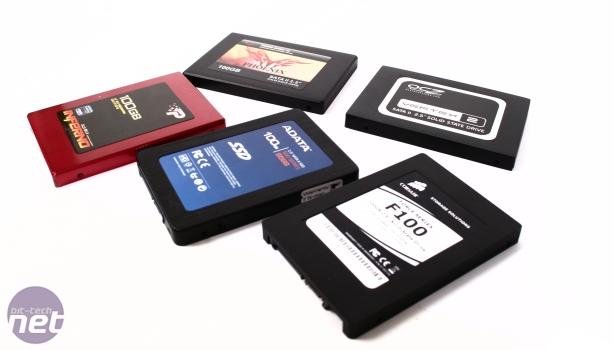
Final Thoughts on SandForce
Having thoroughly tested these five SandForce SSDs, we’re in different minds regarding our opinion not only of them, but of the SandForce SF-1200 and SF-1500 controllers. Our main concern hinges around its approach to compressible and uncompressible data, and the different levels of performance you get from these types of data.As we’ve seen from our testing, SandForce drives can be both incredibly fast, stretching the bandwidth of SATA 3Gbps to the limit, and surprisingly sluggish when faced with data that the compression algorithms are unable to deal with. While the vast majority of files you’ll encounter will be compressible to some extent (the operating systems and game data, for example) some data won’t be, and so will be processed relatively slowly.
However, other SSDs don’t offer quite the consistently high performance of the SandForce drives we’ve looked at. Intel’s X25-M drives might have superlative random read/write performance, but they’re let down by relatively low sequential write speeds. The Gen 2 160GB X25-M costs £350 which works out at a reasonable £2.19 per GB, so at least they're competitive on that front.
Meanwhile, Indilinx drives have delivered on the sequential read and write speeds, but haven’t had killer random write performance.The SandForce controllers are the first to give you your sequential read/write performance cake and eat it with a side of random read/write performance too. And while you won’t be able to eat your cake quite as fast if it’s been compressed, at least you don’t have to pay over the odds to get all this speed.
The decision to release SF-1500 firmware to OCZ (and now all SandForce partners, for a price) also seems an unnecessary, if understandable, one. The SF-1200 firmware drives deliver roughly 45MB/sec of random write speed, more than enough for any home PC, yet the SF-1500 equipped drives are able to deliver 69MB/sec or even 79MB/sec. These speeds aren’t necessary for home use, but as ever bigger numbers are better and will increase sales and profits.
Over Over-Provisioned
The most contentious issue with SandForce, and one we’ve felt continual frustration with throughout this article, is that of over provisioning. SandForce SSDs require more spare NAND space than previous SSDs thanks to having to store references for all the compressed data, but giving up 28 per cent of your NAND is silly unless you’re a server admin and it’s not your money you’re spending.The issue is compounded by the revelation that for home PCs, SandForce drives appear to be perfectly happy with 13 per cent over provisioning, unlocking an extra 18.6GB of usable storage from the same hardware. Needless to say, we’d be annoyed if we’d jumped on the SandForce boat early, only to find out that waiting an extra month or two would have bought us that much extra SSD storage for little (or less) outlay.
We’re hearing rumours of the new 60GB, 120GB, and 240GB firmware being deployed on the 50GB, 100GB and 200GB drives, unlocking the extra storage at the cost of a destructive firmware update. Considering that the only difference between the drives is the firmware, we’d expect nothing less even if the result will be extra strain on SSD manufacturer’s support departments.
The Final Word
In the end, SandForce can be seen as what’s great and what’s terrible about SSDs. Fantastic performance, innovation and capable execution have produced what is obviously a drive controller with a lot of potential, which in the right circumstances is faster than anything else we’ve seen. But it looks like no one has stopped to think whether the product was actually ready for consumers before rushing these 100GB drives out the door. The over provisioning issue will infuriate early adopters whom the manufacturers will now have to placate with a tricky firmware update process in order to deliver the product their customers deserve. Sound familiar?Hopefully the 120GB drives now hitting e-tailers (and our test benches) will prove more worthwhile, but as far as these 100GB SandForce drives go, you’d be well advised to give them a miss, at least until the situation regarding extra capacity via destructive firmware updates has cleared up.

MSI MPG Velox 100R Chassis Review
October 14 2021 | 15:04










Want to comment? Please log in.